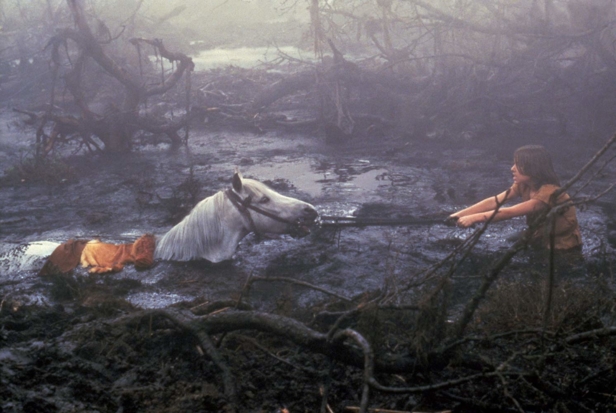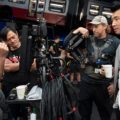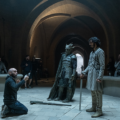From luckdragons to werewolves, rockbiters to giant turtles, The NeverEnding Story is packed with some of the most beloved creatures in fantasy cinema. To mark the film’s 30th anniversary, SciFiNow talks to Oscar-winning special effects director Brian Johnson (Alien, 2001: A Space Odyssey, The Empire Strikes Back) ahead of a special screening at the Genesis Cinema in London on Sunday 9 March about making dreams a reality, the problems with Falkor and why the hardest thing to design is nothing.
You had already worked on Alien and Star Wars before The NeverEnding Story; did the filmmakers come looking for you?
Yeah, they did actually, yes. Well, what actually happened was I was negotiating with Rafaela di Laurentiis to do a picture for her, I was looking at it, but when I actually saw what was up for grabs, I thought “Well, I must pick something else.” Because I wasn’t a fan of the way Dino Di Laurentiis and Rafaela di Laurentiis made their movies. Dino would ride roughshod over the director and just change everything. Then The NeverEnding Story came up, so I took that.
As an effects artist, is creating a fantasy world a different challenge from creating a more sci-fi lanscape?
Well, instead of spacecraft you’ve got clumps of earth and trees! But they still have to be nicely scaled and detailed and everything else, and we used motion control to get the various things that we needed and it wasn’t really very different.
Did you go back and look at the novel, or did you stick to the script?
Whenever an effects person is handed a script, you go by what the script says, not by what the book says because there’s no point. You’ve had meetings with the director and you’re trying to psychoanalyse the director to find out if he’s going to be good or whether he’s going to make your life an absolute misery or [laughs] depends. I’ve been fortunate to work for some brilliant directors but I’ve also met one or two absolute dorks but that’s another story.
Did Wolfgang Petersen let you get on with it?
Yes he did. He was charming, he knew what he wanted, he left me to do most of the second unit stuff, and the wolf sequence and things like that, he was more interested in the artists and those sorts of things. But my contribution was slightly more than just visual effects because I cast some of the people as well. It was my suggestion that they took up because they had problems with some of the people. I got Patricia Hayes and Sidney Bromley and Deep Roy because I knew they’d fit the parts really well. And they turned out to be brilliant.
Was making the film in Germany a different experience for you?
Well, it was different, there’s no question about that. Bavaria Studios had a crew of people that were…some of them were really brilliant, and others weren’t, but that happens all over the place. But there were certain things that happened that used to make us wonder what was going on.
We needed a big blue screen so I designed this, I think it was actually at the time the world’s largest, it was about 95 feet by 35 feet, 90 feet by 35, I can’t remember now, and it was lit with special lights and it was very bright. I went to California to check out the screens from Stuart Screens, and I got them to make one with a double layer of the blue because our lights were so bright and I had to sign a thing that said Stuart Screens weren’t responsible for the quality of the blue. And then I think we bought two, we had two made and we had one shipped to Bavaria so we could start setting up things. The plastic that was used, we knew was temperature critical so I had a note sent to all the departments saying under no circumstances during the winter should the stage doors be left open on the Neu Lampenhaller, which was the big stage, because it could possibly damage the screen. So what happens?
We put the thing up and about the second week of testing I went in on Saturday and the stage doors were wide open, it was about minus five degrees, and a spark dropped a go bo, which is a thing you put in front of the light, dropped it straight through the screen and made a huge hole and that’s before we’d even started shooting. And we didn’t know whether that was sabotage or just inefficiency but anyway, in the main it was a great studio, great people and we got the job done.
 It’s reported to have been the most expensive German film at the time.
It’s reported to have been the most expensive German film at the time.
Probably was, yeah. Well, it wasn’t a big budget by American standards. And Warner Bros didn’t regard it really as a movie, they didn’t even get it nominated for Academy Awards. We were shattered about that because they had other pictures nominated that hardly had anything in them. But anyway, that’s another story.
How was it working with the young cast?
Well, Barret Oliver was an absolute gem. Absolute gem, he was just the best thing ever and Tammy Stronach was fine, and Noah Hathaway was a bit of a pain in the arse, frankly. It was very difficult for Wolfgang to get anything out of him. Barret Oliver delivered all the time, he was just brilliant, absolutely brilliant, and he did Coccoon and a load of other things. Good boy. And then he disappeared, I don’t know what happened to him.
Obviously IMDB trivia pages can’t be trusted but it says that there were some problems with Gmork, was that the case?
Gmork was just a wolf sized wolf, we didn’t have any problems with Gmork, not that I can remember. He was an animatronic wolf and, because Germany is a land full of puppeteers, I got some amazing puppeteers to do all the manipulation, they were really great. And I think we got, considering what we had, we got the best out of what we had, really. That was a lot due to my engineer who was an Italian guy called Giuseppe Tortora, who was absolutely brilliant with mechanisms and also the puppeteers; they did get a real feeling for movements and stuff so that worked out really well I think.
The big threat in the film, Gmork aside, is The Nothing. What did you think when you saw you had to create that?
Well, when you read a script and it says there’s nothing, one’s mind takes a few leaps because you think “How am I going to show nothing?” Because it sounds good on the page but when you actually come down to dealing with it, what is it? So I just sort of had this idea of moving everything like it was all moving into the distance and then breaking up, and just sky and little bits and pieces and couldn’t think what else to do, really. So that was that with the nothing and it worked out reasonably well and we did tricks with the cameras so that stuff flew out the sides of the shots rather than onto the floor and stuff like that. I loved working on the picture, it was a great picture to work on. I had good crew, lots of English and a number of reallly good German people. Wolfgang Lemp and a few others.
Did you have a favourite creation from the film?
Well the thing I liked was the turtle, the radio controlled turtle, he was hysterical. The shaggy golden retriever/dragon [Falkor], which was Wolfgang’s interpretation, worked fine but it didn’t really do it for me. And it was huge and it was difficult moving him around, we couldn’t make him walk. In those days it was impossible. Now with computer graphics, of course, it would be a completely different matter. We had motion control but obviously no computer graphics.
 What is your opinion of the state of effects now? Do you feel like something has been lost with CGI?
What is your opinion of the state of effects now? Do you feel like something has been lost with CGI?
No, well the thing is I notice that models are being combined with CGI now in one or two shows because it does definitely work, I think. Three dimensional models rather than just all CGI because all CGI…I’m not a fan of these violent moves and half a second cuts that go on. It’s OK and it serves its purpose but I like to actually watch what’s on the screen a bit and I think other people do as well. And I’m not a fan of 3D either. Not for any other reason than headaches and sometimes the shots are just done for 3D and they don’t really enhance the production value.
It’s production value that we’re aiming for, at least I was, big production value. As big a bang for the bucks as we could, and it’s not my money that I’m dealing with, it’s somebody else’s. And to just shower money at stuff and say “We’ll do it in post-production” which saves a million faces because if you haven’t worked it out for the main unit shoot, you just say “Oh, we’ll do that in post-production, it will be alright” And that’s why you have the CGI credits run on forever, they’re nearly as long as the movie, aren’t they?
The effects and creatures in The NeverEnding Story are often referenced in pop culture. How does it feel to see your work has made such an impact?
Well, I’m immensely proud of my crew and I feel very satisfied that what we did on the first one wasn’t eclipsed by the second or the third, frankly. We tried really hard and we did a pretty good job. There are always things that could have been better. One of the things that I did which I shouldn’t have done was to use a motion control on the small dragon sequences, we should have just done that with cell animation. And that was a mistake on my part but other than that I think we did pretty well with what we had.
One of the very first films you worked on was 2001: A Space Odyssey. Did it feel like a life-changing experience?
Yes, I went from working on a Gerry Anderson TV show called Thunderbirds, which I left and Gerry told me I’d never work in the iflm industry again, and I wound up on 2001 working with people like Doug Trumbull and Con Peterson, Bruce Logan and Stanley Kubrick of course. And that was something completely different. So yeah, from there, then there was a period when I didn’t do a great deal apart from the odd TV shows and film, but then things started to build up. I was aware that there certain films that needed a huge amount of concentration to make sure that you did the best effort you could. Like Empire, and Alien, and Aliens and Star Wars.
What was it like working with Stanley Kubrick?
Stanley made me realise that if you keep asking the question “Why?” people either run out of answers or you have to go and shoot something else. Because Stanley would always ask the question why but he wouldn’t actually necessarily know why he asked that question. And in terms of special effects, visual effects, he wasn’t really the most knowledgeable person in terms of visual effects. In Doug Trumbull he had a genius heading up the sort of stuff that I was working on, but when Stanley got involved he would say things that made you think “He doesn’t have a clue about how we do these things.”
A simple thing was we used to shoot the moon bus on a track that was made out of girder bridge engineering, you could hit it with a sledge hammer and it wouldn’t vibrate. And we would do these tracks with a camera which was also on a girder bridge system all covered in black velvet and the camera was rocksteady and the camera mechanism we had checked every night with tests so we knew the camera, the actual film running through the mechanism was rocksteady, and yet when we went and actually saw the dailies the next day, the moonbus looked as though it was moving about. Well there was only one possible cause for that. And that was the projector in the theatre was unsteady.
Stanley would not have it, he would not have it, he insisted that Wally Vever strengthened up the rigs, which we never did because there was no point. And it took ages and ages for him to realise the unsteadiness of the projector was what made the thing dance around on the screen. But he’s a hell of a director! And if he didn’t understand those things, well, he didn’t understand them and that’s what we were there for.
 You also worked on the Nostromo for Ridley Scott’s Alien…
You also worked on the Nostromo for Ridley Scott’s Alien…
The Nostromo was not my design. We built it, but the Nostromo was a combination of Ron Cobb and a few other people and Ridley Scott. What happened was the initial shape was determined and I knew, having been working with Ridley for a while on that project, that Ridley was going to change htings because Ridley always did. So I decided to have a model of Nostromo as it was shown on the drawings made about 14 inches, 16 inches long, quite well detailed, and we were shooting at Bray studios at the time. And then I would go to Shepperton studios to see Ridley with the model, ahnd he’d go “Ooh, we need to add this in, we need to do this and do that.” In the meantime we were beginning to build the actual craft.
I waited until Ridley had made about 10 different changes before we committed to building the full complete thing which had big metal spaceframe structure inside it to support all the wood and plywood and stuff, and we put the wickets and things and little plastic kits on top of that. And even then we still added things to the exterior, because Ridley saw it and said “Ooh, let’s have a few more of those whiskers,” those spike things that were sticking out of the front. He kept adding loads of those.
You’ve worked on so many films that have defined the look of science fiction. How does it feel looking back?
Well, it’s very satisfying to see that you were there at the sharp end when it all started. And then you can always improve. When we did Empire Strikes Back, the R2-D2s didn’t work, the radio controlled ones didn’t work in the first one too well. And in fact in the first screenings you could see the wires pulling him along down the corridor. Which were removed for the digital version. But we looked at what they’d done and we improved on that. It will be the same with Nostromo and all those other things. The new people will come along with their money and improve on it.
Brian Johnson will be presenting a Q&A screening of The NeverEnding Story at the Genesis Cinema in Whitechapel on 9 March. For more information and tickets, visit their website.


